Planning Your Water Feature: Site Selection
by Albert V. Short, Fairfax Master Gardener
You’ve always wanted a water feature or pond in your garden. Before you put that shovel in the ground, or contract to install a pond in your garden, what should be your thought process?
First, why a pond or water feature? What are you trying to achieve?
- Is it the look and feel of water in the garden? A pond is a liquid tranquilizer; it’s highly addictive and non-prescription!
- Is it simply an architectural feature to enhance the garden design?
- How will it integrate with your existing or planned garden design?
- How much space do you have, and how much are you willing to devote to a pond?
- Is it to attract birds and wildlife?
- Do you want fish and aquatic plants?
Whatever you install must be maintained.
For simplicity, this article will review two basic styles of water features: a natural pond, (sometimes referred to as “Asian”) and a formal or “European” style feature.
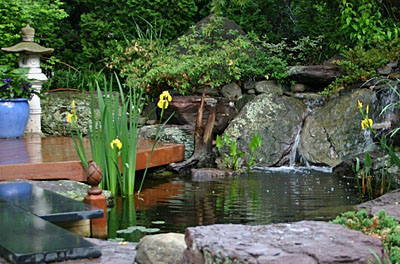
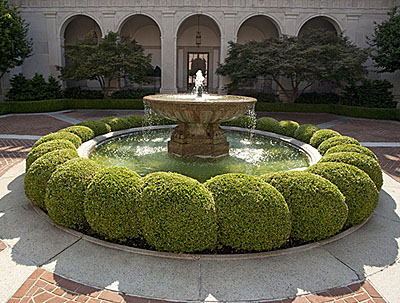
Access considerations to the site will drive the design. Can you get an excavator in to dig the pond basin, or must it be dug by hand? If you dig a hole in your rear garden, it produces a lot of soil. Where is it going to go? For example, a 5 feet x 10 feet x 2 feet deep basin generates 100 cubic feet (about 4 cubic yards) of soil. In this area, most of the generated soil is clay.
 Consider the impact on the existing landscape. Trees have extensive root systems, and if you install a pond under a tree, you’re either going to interfere with its root system or kill it. In the fall, the basin will be full of leaves. Some trees including evergreens and walnut should be avoided as the sap will kill fish and discolor the water. Another reason to stay away from trees is sunlight. Most aquatic plants, especially water lilies, require at least six hours of sunlight to prosper.
Consider the impact on the existing landscape. Trees have extensive root systems, and if you install a pond under a tree, you’re either going to interfere with its root system or kill it. In the fall, the basin will be full of leaves. Some trees including evergreens and walnut should be avoided as the sap will kill fish and discolor the water. Another reason to stay away from trees is sunlight. Most aquatic plants, especially water lilies, require at least six hours of sunlight to prosper.
A pond in Fairfax County that’s over 24 inches deep is considered a “swimming pool” by regulation, and it requires permits and safety fencing, etc. If it is less than 24 inches deep, you satisfy the County requirements. We are not in Florida, so your pond will freeze in winter and should be designed with that in mind. That dictates a pond depth less than 24 inches and a water volume sufficient for fish to winter over in the pond. If fish are not desired, pond depth can be shallower, but total water volume is still important to maintain proper water balance.
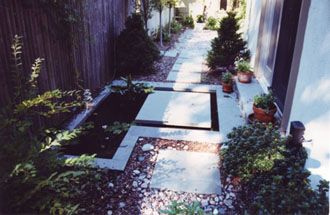 A pond requires electrical service (110 volt) at the basin and access to water. Electrical service must be professionally installed with a GFCI circuit, and the pump plug outlet must be located 10 feet from the basin. Drainage around and out of the basin must be planned. Ground water should not run into the basin. In a heavy rain, the basin will overflow, and the design must accommodate this runoff. A low spot in the garden is NOT a good place to install a pond basin. It will be prone to flooding out from runoff, and a rubber membrane liner is likely to get water under it, blow up and eject its water and fish into the garden.
A pond requires electrical service (110 volt) at the basin and access to water. Electrical service must be professionally installed with a GFCI circuit, and the pump plug outlet must be located 10 feet from the basin. Drainage around and out of the basin must be planned. Ground water should not run into the basin. In a heavy rain, the basin will overflow, and the design must accommodate this runoff. A low spot in the garden is NOT a good place to install a pond basin. It will be prone to flooding out from runoff, and a rubber membrane liner is likely to get water under it, blow up and eject its water and fish into the garden.
In establishing the basin location consider the “look angles.” Where are you going to view this water feature from? From a deck, a patio, the lawn or from within the home? The basin’s location should be driven by where you can see it best considering all the various look angles and seasons. It ends up being a compromise decision to maximize the look angles, but it is critical because a few feet one way or the other can make a big difference in how the feature works in the garden.
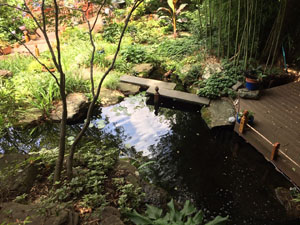 The size of your water feature must fit the site, and as a rule the basin should have a length to width ratio of 1.5 to 1. This ratio is especially true in natural ponds, where an egg-shaped, or round “natural” pond simply looks “unnatural.” A traditional or European style feature can be designed with more linear shapes, circles, squares, etc. Another aspect of size is its fit in the overall landscape design. The pond or water feature should not look like it was parachuted into your rear garden. It must be integrated with the garden design.
The size of your water feature must fit the site, and as a rule the basin should have a length to width ratio of 1.5 to 1. This ratio is especially true in natural ponds, where an egg-shaped, or round “natural” pond simply looks “unnatural.” A traditional or European style feature can be designed with more linear shapes, circles, squares, etc. Another aspect of size is its fit in the overall landscape design. The pond or water feature should not look like it was parachuted into your rear garden. It must be integrated with the garden design.
The basin itself is only the water surface. The area surrounding your pond will have some type of hardscape and/or landscape. The space in the garden consumed by a water feature will be about 50 percent larger than the length and width of the basin. Thus a 10 feet x 15 feet natural pond would use a space about 15 feet x 22 feet in the garden.
 |
 |
|
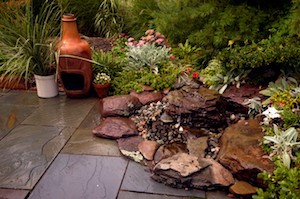 |
||
Many homes and townhouses in Fairfax have small rear garden areas. A small water feature integrated into the landscape, a deck or patio can be very effective. These features are usually for close viewing, so detail in the design and installation is very important. The photos below show various small water features that illustrate this point.
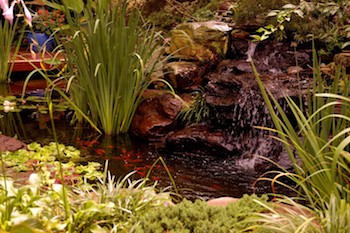 During my over 25-year ownership of a garden pond design company and having looked at a lot of homeowner-built ponds, almost universally the pond owner after a year would say, “I built it too small.”
During my over 25-year ownership of a garden pond design company and having looked at a lot of homeowner-built ponds, almost universally the pond owner after a year would say, “I built it too small.”
This article has discussed the major considerations in site selection for a garden water feature. Future articles will cover pond installation techniques and materials, fish and aquatic plants, and maintenance.
References
Jane Adams Memorial Stream Garden, Hahn Horticultural Garden
Urban Water Quality Management, Wildlife in the Home Garden, Virginia Cooperative
Extension
. . . updated 2023